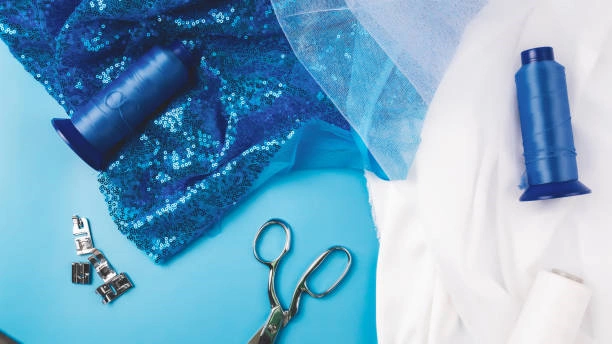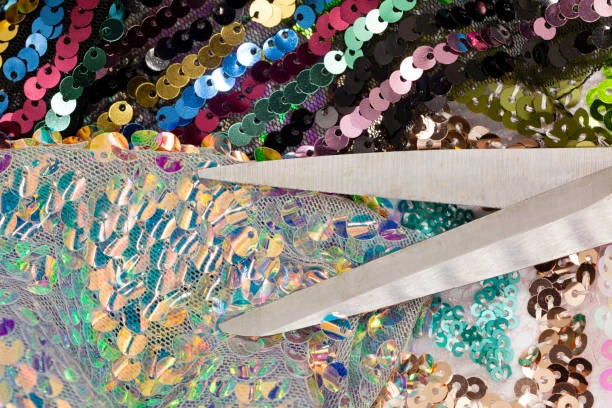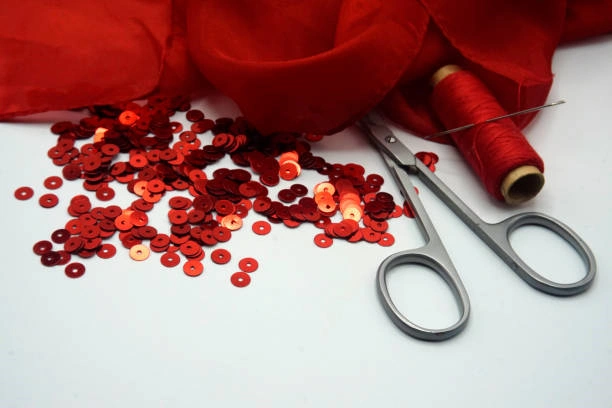Cutting sequins may seem daunting, but precise cutting is the absolute foundation for creating any beautiful sequined garment. Many seamstresses get nervous at this stage, but with the right approach, you can achieve stunning results. Learning these basic sequin cutting tips will help you create clean edges, minimize annoying fraying, and ultimately lay the foundation for sparkling success for your entire sequin project. We’ll show you the best ways to cut sequins so your dazzling designs come to life, just as you imagined.
Essential Tools for Cutting Sequin Fabric

Having the right arsenal of cutting sequin fabric tools is paramount for a smooth and successful experience. Don’t skimp on quality here; the right tools will save you frustration and ensure beautiful results.
A. The Right Scissors Make All the Difference:
When it comes to cutting sequin fabric, your scissors are your primary weapon. Sharp scissors for fabric are crucial to prevent snagging the delicate base fabric or individual sequins, ensuring clean, precise cuts. Invest in dedicated fabric shears or tailor’s shears and reserve them only for fabric. Avoid using dull scissors or any scissors that have been used for paper, as paper quickly dulls blades, making them unsuitable for fabric, especially sequins.
B. Rotary Cutters:
A rotary cutter for sequins can be a great asset, particularly for achieving perfectly straight lines and very long cuts. However, caution is key. Always use a self-healing mat underneath and ensure your rotary cutter has a brand-new, sharp blade. Be aware of the potential for blade damage from sequins, especially larger or thicker ones. You might need to pick off sequins directly in the cutting path if using a rotary cutter.
C. Marking Tools for Accuracy:
To transfer pattern markers, you can choose tailor’s chalk, a washable fabric pen, or a tracing wheel with tracing paper. Traditional pins may not be ideal because they may snag the sequins, damage the base fabric, or even bend.
D. Securing Your Fabric:
Sequin fabric can be slippery and heavy, making it prone to shifting. Fabric weights are essential for holding your pattern pieces securely, preventing distortion. As an alternative to pins, fabric clips are excellent for securing layers without piercing the fabric or interfering with sequins.
Preparing Your Sequin Fabric for Cutting

Before you make that first snip, proper preparation of your sequin fabric is paramount for a smooth and successful cutting process. This stage is where you truly set your project up for success.
Laying Out Your Fabric Properly:
Find a flat, clean surface large enough to accommodate your fabric and pattern pieces. Carefully spread out your sequin fabric, ensuring there are no wrinkles or puckers. Any unevenness at this stage will transfer to your cut pieces, leading to distorted shapes later.
Understanding the Sequin Nap (Direction):
Most sequin fabrics have a “nap” or a specific direction in which the sequins lie flat, giving them a smoother feel and consistent sheen when brushed one way. Run your hand across the fabric to identify this direction. It’s crucial to ensure all your pattern pieces are cut with the sequins lying in the same direction for uniform shimmer and drape. For reversible sequin fabric, pay extra attention to how the sequins will flip on your final garment.
Strategic Sequin Removal from Seam Allowances (Crucial Step!):
This is perhaps the most important tip for how to prepare sequin fabric for cutting and, ultimately, sewing. Removing sequins before cutting within your seam allowances is necessary. Why? It prevents broken needles, eliminates uncomfortable bulk at the seams, and allows your seams to lie flat. To do this, carefully snip the threads holding individual sequins within your cutting sequin fabric seam allowance. Be meticulous to avoid cutting the base fabric.
How to Cut Sequin Fabric

Once your sequin fabric is prepped, it’s time to put your tools to good use. These step-by-step techniques will guide you in cutting sequin fabric accurately, ensuring clean edges and precise pattern pieces.
Pattern Placement and Pinning/Weighting:
Start by laying out your pattern pieces efficiently on the fabric. This not only helps you conserve material but also allows you to double-check the nap direction of your sequins for all pieces. Instead of traditional pins, which can snag or damage sequins, opt for fabric weights to hold your pattern pieces firmly in place. If you must use pins, insert them carefully within the seam allowance, making sure they don’t catch on any sequins. This gentle approach is key to the best way to cut sequin fabric without distorting it.
Cutting Single Layers vs. Folded Fabric:
For maximum accuracy, especially when working with slippery or how to cut stretch sequin fabric, the best practice is to cut in a single layer. This minimizes shifting and ensures that both sides of your pattern piece are identical. If your pattern requires a “cut on fold,” and cutting a single layer isn’t feasible, ensure the fabric is perfectly aligned along the fold. Use extra weights or clips along the fold line to prevent any movement. Be extra meticulous when cutting through multiple layers of sequin fabric, as the bulk can make precise cutting challenging.
Precise Cutting Strokes:
Whether you’re using scissors or a rotary cutter, the quality of your cuts directly impacts your final garment. When using scissors, aim for long, smooth cuts rather than short, choppy ones. This helps in avoiding jagged edges and ensures a cleaner finish. For intricate curves or tight corners, use the very tip of your sharp scissors, making small, controlled snips. Take your time; rushing can lead to errors that are difficult to correct with sequin fabric.
Handling Sheer or Mesh-Backed Sequin Fabric:
Delicate base fabrics, common with many sequin designs, require extra care. If you’re working with very sheer or flimsy mesh-backed sequin fabric that tends to shift or stretch, you might find it helpful to place a layer of tissue paper underneath before cutting. This provides stability and helps the fabric lie flat, making it easier to achieve clean, accurate cuts, and further contributes to the best way to cut sequin fabric when it’s particularly challenging. This also aids in how to cut stretch sequin fabric by minimizing distortion.
Managing Sequin Shedding

It’s essential to finish your sequined fabric project neatly, and that starts with dealing with the inevitable shedding of sequins. It’s completely normal for some sequins to fall off after cutting, so keep a small trash can nearby and consider working on an easily cleanable surface. To prevent fraying, trim the raw edges before you begin sewing.
While sequins can be messy to handle, methods such as careful hemming, stapling, or lightly applying a scuff protector can help, though lining generally provides the best closure. Finally, when storing your cut sequins, always lay them flat to avoid wrinkling or crushing the delicate embellishments. This meticulous post-cutting care will ensure your dazzling fabrics are in top condition for sewing.
Conclusion
By understanding the right tools, meticulous preparation, and effective sequin fabric cutting techniques, you’re well-equipped to tackle any dazzling project. Remember, a good cut is the foundation for a good sew – it sets you up for smooth stitching and a beautiful finished garment.
Don’t let the sparkle intimidate you; instead, embrace the shine and create something truly unique. Do you have any favorite tips for cutting sequin fabric or exciting sequin project ideas you’re eager to try? Share them below!
